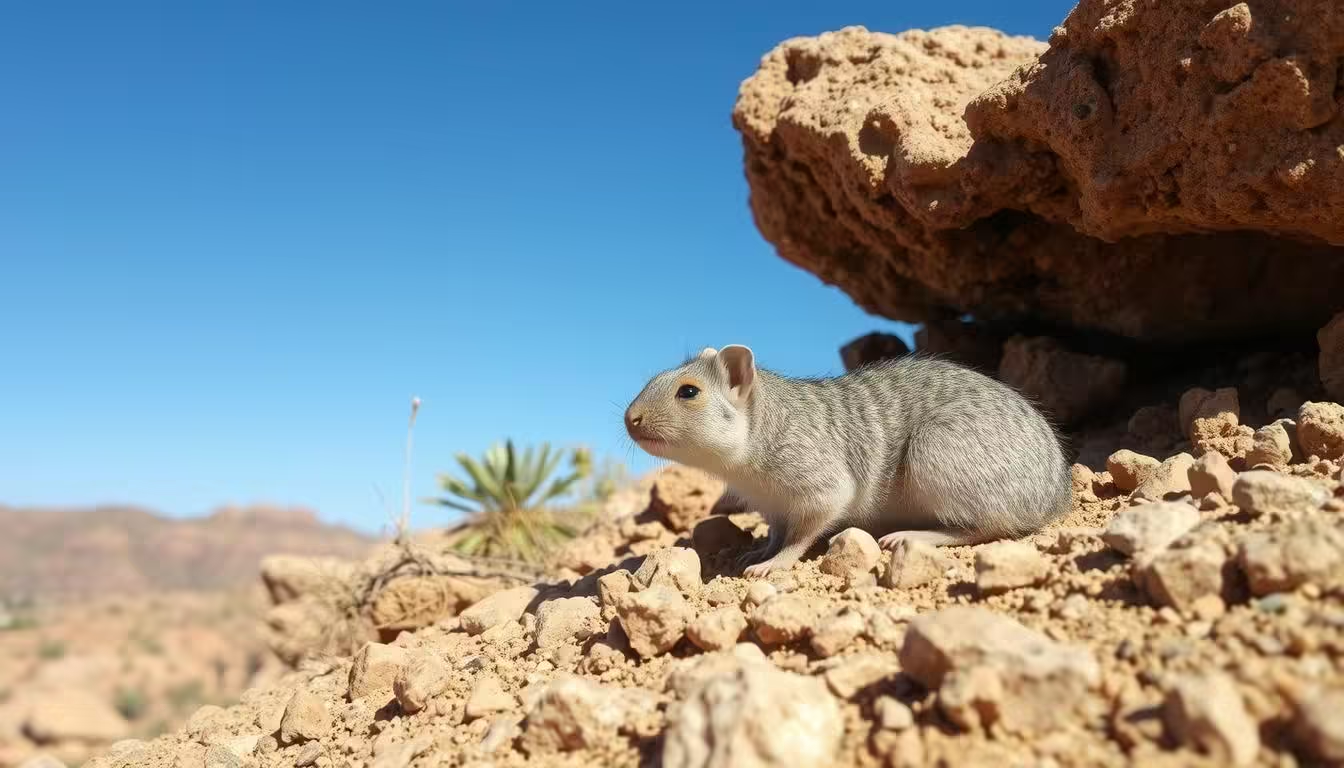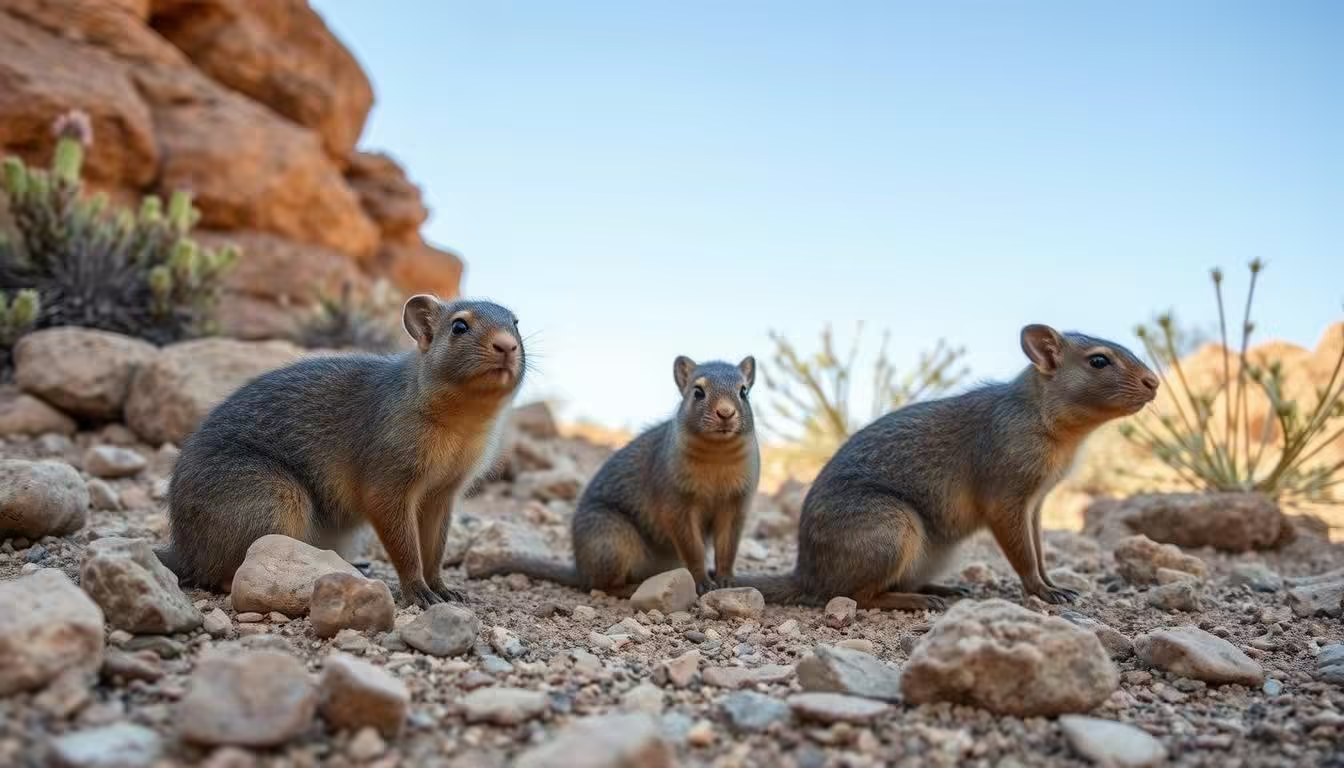In Brazil’s Northeast, the Caatinga biome stands out. It’s a dry tropical forest that covers over 330,000 square miles. Here, the rock cavy (Kerodon rupestris) thrives despite the dry conditions. These small mammals have adapted to survive with very little water.
The Caatinga’s climate is harsh, with very little rain and long dry spells. Droughts hit every 30 to 40 years, making life tough for animals. But the rock cavy has found a way to not just survive but also flourish in this tough environment.
Key Takeaways
- The Caatinga biome of Northeast Brazil is characterized by a thorn-scrub ecosystem with limited water resources and unpredictable rainfall patterns.
- Rock cavies, a small mammal species endemic to the Caatinga, have developed remarkable adaptations to conserve water and thrive in the arid landscape.
- These adaptations include specialized metabolic strategies, dietary choices, and burrowing behaviors that help rock cavies access water and protect themselves from the harsh environmental conditions.
- Understanding the survival strategies of rock cavies in the Caatinga provides insights into the resilience of life in extreme environments.
- Preserving the rock cavy and its habitat is crucial for maintaining the overall biodiversity and ecological balance of the Caatinga biome.
Introduction to the Caatinga Biome
The Caatinga biome is in Northeast Brazil. It’s not just dry and arid. It’s a vast, unique ecosystem with diverse plants and many species.
This biome covers about 330,000 square miles. It has dense forests, cacti, and many unique plants and animals.
Unique Features of the Caatinga
The Caatinga is full of life, with over 1,500 plant species. Among them, 318 are found only here. It’s a hotspot for biodiversity.
It’s home to 2,587 freshwater fish, 175 reptiles and amphibians, and 156 mammals. Many of these have adapted to the harsh conditions.
Climate and Its Challenges
The Caatinga’s climate is unpredictable. It gets just 12 to 40 inches of rain in 3-5 months. Then, it faces severe droughts every 30-40 years.
Temperatures can reach up to 50°C (122°F). This makes life hard for the South American rodents living here.
Despite the challenges, the Caatinga thrives. It’s full of life, thanks to the plants and animals that have adapted to survive.
Next, we’ll explore the rock cavy, or mocó. It’s one of the unique creatures of the Caatinga.
“The Caatinga is a true treasure trove of biodiversity, boasting over 1,500 recorded plant species, with an astounding 318 species found nowhere else on Earth.”
Overview of Rock Cavies
Rock cavies (Kerodon rupestris) are amazing South American rodents. They live in Brazil’s Caatinga biome, a very dry area. These rodents have special features and behaviors that help them survive in tough conditions.
Physical Characteristics
Rock cavies are sturdy and medium-sized, weighing 1.5 to 2.5 kg. They have short, rounded bodies and short limbs. Their head is small with big, sticking-out eyes.
Their fur is thick and can be reddish-brown or grayish-brown. This color helps them blend in with the rocks. They also have strong, curved claws for climbing and moving around.
Behavioral Traits
- Rock cavies live in groups of up to 20, showing they are very social.
- They are super agile, moving easily through the rocky Caatinga.
- They are mostly active during the day and rest in burrows or crevices at night.
- Their sounds, like high-pitched whistles and alarm calls, help them talk and connect with each other.
Rock cavies have amazing physical and behavioral traits. These help them live well in the harsh Caatinga. They show how resilient these South American rodents are against tough environments.
Adaptations for Water Conservation
The rock cavies of Brazil’s Caatinga biome have amazing ways to survive with little water. They have special ways of using their bodies and what they eat. This lets them live well in places where water is scarce.
Metabolic Strategies
Rock cavies have ways to save water. They can lower their body temperature and breathe slower when it’s very hot. This helps them keep their body’s moisture safe.
They also keep their body temperature steady, even when it’s extremely hot. This is a big help in the Caatinga’s harsh climate.
Dietary Choices
Rock cavies mainly eat plants that don’t need much water, like cacti and succulents. These plants give them the nutrients they need and have lots of moisture. This lets the rock cavies get the water they need from their food.
Rock cavies have evolved to live well in the dry Caatinga. Their unique ways of using their bodies and eating help them survive in places with very little water.
The Role of Burrowing in Survival
In the dry Caatinga biome of Brazil, rock cavies have found a way to survive. They burrow into the rocky ground. This creates hidden spaces that protect them from the harsh weather.
Creating Microhabitats
Rock cavies build complex burrows using the rocky terrain. These underground homes keep them safe from the sun, wind, and extreme temperatures. They also help the rock cavies save water and keep a stable environment.
Protecting Against Predators
Rock cavies use their burrows to hide from predators. They can avoid foxes, raptors, and snakes in the Caatinga. This is a key way they stay safe in the dry landscape.
Through burrowing, rock cavies have found a way to thrive in the Caatinga. This shows their amazing ability to adapt and their role in the ecosystem.
Water Sources in the Caatinga
The Caatinga biome is a unique ecosystem in northeastern Brazil. It has an arid and semi-arid climate. Rock cavies, a small rodent species, survive here by adapting to the limited water. Knowing the water sources in the Caatinga helps us understand how these creatures thrive.
Rainfall Patterns
The Caatinga has a rainy season that lasts 3 to 5 months. During this time, it gets between 12 to 40 inches of rain. But, the rain can be unpredictable, with severe droughts happening every 30 to 40 years. Rock cavies have learned to conserve and use water, even when it’s scarce.
Natural Water Bodies
There are few permanent water sources in the Caatinga, with the São Francisco River being the main one. Seasonal pools and streams offer a brief but vital source of water. Rock cavies and other animals have adapted to find and use water efficiently. This allows them to survive in the Caatinga biome survival with minimal water survival.
| Water Source | Availability | Importance for Rock Cavies |
|---|---|---|
| Seasonal Rainfall | 3-5 months per year | Provides a crucial source of hydration during the wet season |
| Ephemeral Water Bodies | Temporary, dependent on rainfall | Offer a vital, yet fleeting, source of water for the rock cavies |
| São Francisco River | Permanent, year-round | The only significant perennial water source in the Caatinga |
The rock cavies’ amazing adaptations and the unique water sources in the Caatinga help them thrive. Understanding the balance of water in the Caatinga is key to saving the region’s biodiversity. It’s also crucial for the long-term survival of the rock cavy population.
Impact of Human Activities
The Caatinga ecosystem in northeastern Brazil is home to the rock cavy, a small rodent. This area faces big threats from human actions, putting the rock cavy’s survival at risk.
Habitat Disruption
The Caatinga biome covers about 844,453 km² or 11% of Brazil. It has lost 40% of its original vegetation. This loss is due to urban growth, farming, and livestock.
This habitat loss affects the rock cavy’s natural range and ability to survive.
Conservation Efforts
Many conservation efforts are underway to protect the Caatinga’s biodiversity. The rock cavy is listed as threatened in Brazil. This shows the need for specific protection plans.
These plans aim to keep the rock cavy’s unique adaptations alive. They ensure the species continues to exist in the region.
But, challenges are big. The Caatinga’s rural communities depend on activities like farming and raising livestock. These activities can harm the ecosystem. Working together is key to finding solutions that meet both human and ecological needs.
The Caatinga and its inhabitants, like the rock cavy, face growing threats. We need strong conservation plans. By understanding the rock cavy’s adaptations and the impact of human activities, we can help the Caatinga’s biodiversity thrive.
Interactions with Other Species
The rock cavies of the arid Caatinga biome in Brazil don’t live alone. They share their home with many other species. These South American rodents must balance their relationships and behaviors to survive in the harsh environment.
Competitive Relationships
Rock cavies are herbivores, competing for food and water with other plant-eaters in the Caatinga. They face off with other rodents and larger animals like deer and peccaries. This competition can lead to fights over food and water, testing their survival skills.
Symbiotic Behaviors
Rock cavies have special relationships with certain plants in the Caatinga. They help spread seeds, which aids in the growth of native plants. This helps keep the ecosystem balanced.
Also, rock cavies affect the predator-prey balance in the Caatinga. They are prey for larger carnivores like ocelots. Their ability to survive in this tough environment shows the resilience of the Caatinga’s biodiversity.
| Species | Interaction with Rock Cavies | Impact on Caatinga Ecosystem |
|---|---|---|
| Ocelots | Prey on rock cavies, helping regulate their population | Maintains predator-prey balance in the biome |
| Deer and peccaries | Compete with rock cavies for limited food and water resources | Drives competition for scarce resources, potentially affecting the overall ecosystem dynamics |
| Native plant species | Rock cavies aid in seed dispersal, contributing to plant regeneration | Supports the maintenance and resilience of the Caatinga’s unique vegetation |
Understanding the complex interactions of rock cavies in the Caatinga biome helps us see their vital role. They play a key part in keeping this arid ecosystem balanced.
Importance of Rock Cavies in Their Ecosystem
Rock cavies are found only in the dry Caatinga biome of Brazil. They are important for keeping the ecosystem balanced. As rock cavy water adaptation experts, they help spread seeds, which boosts plant variety in the arid ecosystem adaptations.
Role in Seed Dispersal
Rock cavies eat seeds and fruits as they roam the Caatinga. They scatter these seeds, helping plants spread out. This is key for the Caatinga’s plants to grow and thrive in tough conditions.
Contribution to Biodiversity
Rock cavies are a key part of the Caatinga’s biodiversity. They show how healthy the ecosystem is. By living among other species, they help keep the Caatinga’s plants and animals in balance.
“Rock cavies are a keystone species in the Caatinga, playing a vital role in the dispersal of seeds and the maintenance of the region’s biodiversity.”
Rock cavies are crucial to the Caatinga. They spread seeds and help keep the area’s plants and animals diverse. These adaptable rodents are vital for the Caatinga’s survival.
Conclusion: Survival Against the Odds
The rock cavy’s ability to thrive in the harsh Caatinga environment is amazing. But, the future of the rock cavy and the Caatinga ecosystem is uncertain. Climate change and human activities pose big challenges.
Future of Rock Cavies in a Changing Climate
Climate change is causing more severe droughts in the Caatinga. This could make it hard for rock cavies to survive. They might not have enough water and food. It’s important to keep studying and monitoring them to find ways to help.
Call to Action for Conservation Efforts
The Caatinga’s biodiversity, including the rock cavy, is at risk. Habitat destruction and unsustainable activities are major threats. We need to protect the region’s key areas, like the high wet forests and the dunes of the São Francisco river.
These areas are home to many unique species. Raising awareness, making policy changes, and working together on conservation efforts can help. This way, we can ensure the rock cavy and the Caatinga’s ecosystem have a future.



